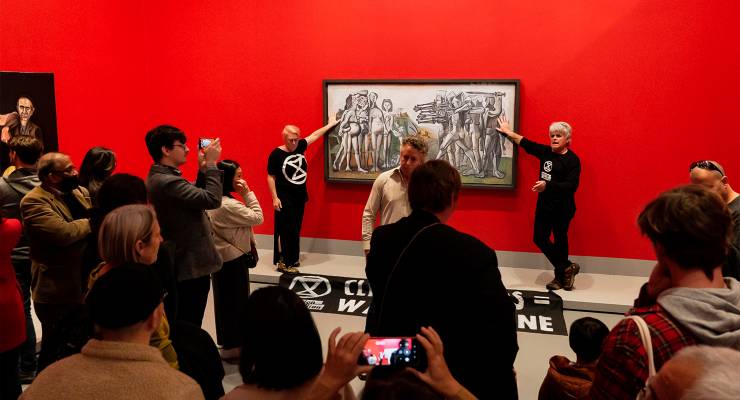
Pablo Picasso, on the political importance of art, claimed “painting is not done to decorate apartments. It is an instrument of war.”
In the fight for the planet, Extinction Rebellion is looking for any and all peaceful methods by which to put the climate and ecological emergency where it belongs: on the front pages of every newspaper and the start of every news bulletin, every day.
On Sunday we achieved this when two activists glued themselves to the perspex of a Picasso at the National Gallery of Victoria.
Art, at its best, is confronting, challenging and sometimes life changing. The painting targeted, Massacre in Korea, was already a political statement on the horrors of war. This made a perfect piece for action on how global warming will increase conflict of all sorts, as resources dwindle and famine and extreme weather displace unthinkable numbers of people.
The target for actions like these is not Rebecca Huntley’s “disengaged, uncertain or sceptical” focus group participants discussed in Charlie Lewis’ piece yesterday in Crikey. It is the growing number of people convinced that the climate emergency is a real and immediate threat, and who are at the point where they can see that taking action — direct, meaningful action — is the way forward.
Keeping climate in the public eye in any form is a win. Just as COVID has been front and centre in every aspect of our lives during the pandemic, so should the effects of climate change on our planet. We only have one chance to get this right.
If a few people’s afternoons at the gallery are disrupted to do this, it is sad and annoying, but this sorrow is vastly overshadowed by the suffering of those already directly affected by a changing climate — such as the tens of millions in Pakistan flooded this year, or the billions of animals burnt to death or harmed in the 2019-20 bushfires.
We also, unfortunately, have to find novel ways to get this attention. In an ABC media interview yesterday, when mentioning tragedies like Pakistan, the bushfires and what has happened in Lismore, I was met with a very dismissive “Oh, I’ve heard all that before” from the host.
To live in comfort and to be able to shrug off such incredible suffering as yesterday’s news, a bit boring, and not relevant to why people might be wanting to call attention to the environment shows how, even though most people have some understanding of the problem, most Australian lives are still disconnected from what is unfolding. It won’t stay like this for long.
Using art as a way to try to connect people’s emotions to the crisis, to touch something that we know matters to people who may be able to make a difference, is a gamble certainly, but waiting for the perfect action that won’t upset anyone is a greater gamble still.
Picasso, the controversial artist and lifetime pacifist (and, to be fair, a problematic misogynist), would probably see our actions as bold and in the spirit of his art.
We invite lovers of his work to move beyond the shock of the event and feel the fear that we, and so many others, are experiencing over what we are doing to our home planet. And to think about joining us. It’s not too late.
Do you agree Australians need to be ruffled a bit from their complacency? Let us know your thoughts by writing to letters@crikey.com.au. Please include your full name to be considered for publication. We reserve the right to edit for length and clarity.








Guernica, the painting that made Picasso famous, was also a political statement. As a favour to Franco, Hitler had the Luftwaffe demonstrate his new concept of blitzkrieg by bombing this little town. The Luftwaffe included the use of Stuka dive bombers, which used sirens on the wingtips to increase the terror. The world’s press amplified the horror, which Picasso expressed in his painting of injured horses and frightened townsfolk. Later events eclipsed the event, but the reputation of the painting lived on, and the (rather mediocre) artist became rich and famous.
The way this was reported in the MSM was disgraceful. It was reported as “glued to a Picasso painting”. Another deliberate miss-reporting in an attempt to denigrate ER.
Climate inaction didnt happen because there were no votes in fixing it but because there was planty of money in keeping it going courtesy of the fossil fuel people. Polititians are doing quite nicely out of global warming thank you.
The question I would have is whether this action is going to anything other than draw attention to the group? Stunts like this are usually condemned because they are just that – stunts. If it doesn’t engage in ways to change the body politic, then the stunt should be rightly seen as little more than an exercise in doing something rather than doing something effecting.
But, hey, it might have worked. I doubt the group is measuring how effective it is as a tool for action beyond seeing how much attention it brings, and then all it means is activism has been reduced to fleeting attention-seeking.
This ‘stunt’ is one action among many which XR people participate in. We are out there weeding, protecting native forest coops, speaking with politicians, attending rallies and so much more. Placing the issue front and centre of people’s mind, as this action does, is one way to encourage more people to persuade politicians to act on this crisis. It’s easy to criticise what other people do – I’d rather criticise fossil fuel extraction and logging companies and governments that support them.
“Placing the issue front and centre of people’s mind, as this action does, is one way to encourage more people to persuade politicians to act on this crisis.”
Is this being measured at all? Or are you equating people talking about the stunt with people taking actions that address climate change?
Like the people who stand on a main road with a “honk for climate change” sign, we should question whether it is meaningful for political action. “But people are honking, so it must mean we are having all effect.” It can only be known if it’s measured. Without it, it’s speculation.
“I’d rather criticise fossil fuel extraction and logging companies and governments that support them.”
Are you suggesting that because there are bigger fish to fry, we shouldn’t consider how efficacious stunts like this are for the cause?
The honks could also represent those that believe these professional whingers should go and get a job and do something useful for a change. Now that would really be a shock!
Have you ever actually done any research to see whether it does “put the issue front and centre of mind”, at any rate among those few people in Australia today for whom it isn’t there already? If so, how does it achieve that effect?
The logic reminds me of that famous syllogism from Yes, Minister:
“Something must be done.
This is something.
Therefore, it must be done.”
Anyway, I hope the native forest chooks are grateful to you for protecting thier coops.
And it’s likely that stunts will be mis-reported – as per MSM.Any action needs to consider how it will be mis-reported and then considered by people in general. This is the reason I haven’t joined XR.
These professional whingers are a PITA and do absolutely nothing for their “cause” (this weeks anyway). Everyone is well aware of climate change but we also know that there is no quick fix and that change will occur in an orderly manner. They whinge and whinge and disrupt everyone yet offer no viable solutions. You can’t just turn everything off.
That dismissive response of the ABC journo is pathetically sub-par, worthy only of a right wing shock jock. WTF ABC.
And WTF Australia – I wanna grab 19/20 of my fellow Australians by the lapels and shake and shout and headbutt. Pack of goddamn fwits.
Oh yeah – perhaps some of the folks reading this might try considering whether we might get a bit more done minus some of the circular firing squad business…